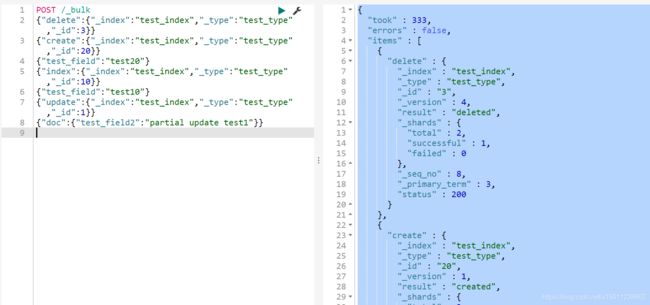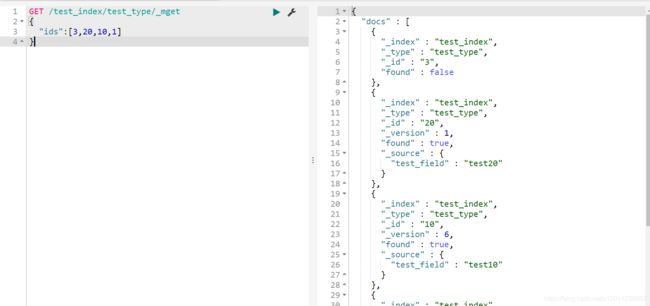2019最新ElasticSearch6.5.4bulk批量增删改
1.bulk语法格式:
注意: bulk api对json的语法,有严格的要求,每个json串不能换行,只能放在一行,多个类型的json串之间,必须换行
POST /_bulk
{"delete":{"索引名称":"索引值","类型名称":"类型值","id名称":id值}}
{"create":{"索引名称":"索引值","类型名称":"类型值","id名称":id值}}
{实际数据存放的地方}
{"index":{"索引名称":"索引值","类型名称":"类型值","id名称":id值}}
{实际数据存放的地方}
{"update":{"索引名称":"索引值","类型名称":"类型值","id名称":id值}}
{"doc":{实际数据存放的地方}}
2.可操作的类型:
2.1:delete:删除一个文档,只要一个json串就行了
2.2:create: PUT/index/type/id,强制创建一个文档
2.3:index:普通的PUT操作,可以是新建文档,也可以是全量替换文档
2.4:update:执行partial update操作
3.代码:
POST /_bulk
{"delete":{"_index":"test_index","_type":"test_type","_id":3}} 删除id为3的数据
{"create":{"_index":"test_index","_type":"test_type","_id":20}} 创建一个id为20的文档
{"test_field":"test20"} 往文档里面加入数据(test20)
{"index":{"_index":"test_index","_type":"test_type","_id":10}} 全量替换 id为10的文档
{"test_field":"test10"} 替换文档内的全部数据
{"update":{"_index":"test_index","_type":"test_type","_id":1}} 修改id为1的文档
{"doc":{"test_field2":"partial update test1"}} 更新数据
注意:bulk操作中,任意一个操作失败,是不会影响其他的操作的,但是在返回结果里,会有一个异常日志
4.运行结果
{
"took" : 333,
"errors" : false,
"items" : [
{
"delete" : { 删除
"_index" : "test_index", 索引
"_type" : "test_type", 类型
"_id" : "3", id
"_version" : 4, 版本
"result" : "deleted", 删除结果
"_shards" : {
"total" : 2,
"successful" : 1, 删除成功
"failed" : 0
},
"_seq_no" : 8,
"_primary_term" : 3,
"status" : 200
}
},
{
"create" : { 创建
"_index" : "test_index", 索引
"_type" : "test_type", 类型
"_id" : "20", id
"_version" : 1, 版本
"result" : "created", 创建结果
"_shards" : {
"total" : 2,
"successful" : 1, 创建成功
"failed" : 0
},
"_seq_no" : 7,
"_primary_term" : 3,
"status" : 201
}
},
{
"index" : {
"_index" : "test_index",
"_type" : "test_type",
"_id" : "10",
"_version" : 6,
"result" : "updated",
"_shards" : {
"total" : 2,
"successful" : 1,
"failed" : 0
},
"_seq_no" : 14,
"_primary_term" : 3,
"status" : 200
}
},
{
"update" : {
"_index" : "test_index",
"_type" : "test_type",
"_id" : "1",
"_version" : 3,
"result" : "updated",
"_shards" : {
"total" : 2,
"successful" : 1,
"failed" : 0
},
"_seq_no" : 5,
"_primary_term" : 3,
"status" : 200
}
}
]
}
GET /test_index/test_type/_mget
{
"ids":[3,20,10,1]
}
验证结果
{
"docs" : [
{
"_index" : "test_index",
"_type" : "test_type",
"_id" : "3",
"found" : false 已删除,显示false 表示不存在
},
{
"_index" : "test_index",
"_type" : "test_type",
"_id" : "20",
"_version" : 1,
"found" : true, 创建成功
"_source" : {
"test_field" : "test20" 数据
}
},
{
"_index" : "test_index",
"_type" : "test_type",
"_id" : "10",
"_version" : 6, 首先看版本号,已经不一样了,表示全量覆盖了
"found" : true,
"_source" : {
"test_field" : "test10" 数据已经改变了
}
},
{
"_index" : "test_index",
"_type" : "test_type",
"_id" : "1",
"_version" : 3,
"found" : true,
"_source" : {
"test_field1" : "test field1",
"test_field2" : "partial update test1" 更新的数据
}
}
]
}
格式:
POST/index/type/_bulk
{"delete":{"id名称":id值}}
{"create":{"id名称":id值}}
{实际数据存放的地方}
{"index":{"id名称":id值}}
{实际数据存放的地方}
{"update":{"id名称":id值}}
{"doc":{实际数据存放的地方}}
代码:
POST /test_index/test_type/_bulk
{"delete":{""_id":3}}
{"create":{"_id":20}}
{"test_field":"test20"}
{"index":{"_id":10}}
{"test_field":"test10"}
{"update":{"_id":1}}
{"doc":{"test_field2":"partial update test1"}} 也可以这样写
bulk size最佳的大小:
bulk request会加载到内存里,如果太大的话,性能反而会下降,因此需要反复尝试一个最佳的bulk seize。
一般从10005000条数据开始,尝试逐条增加,大小最好在515MB之间

